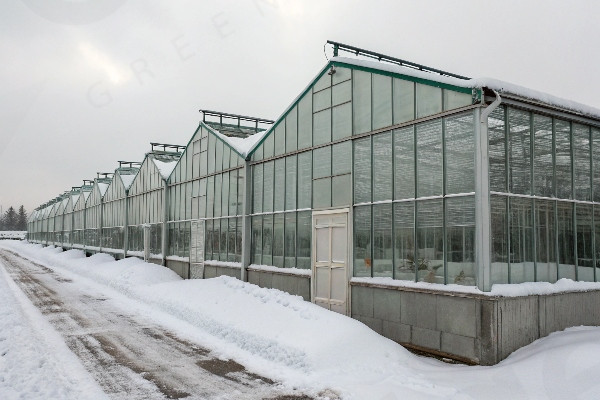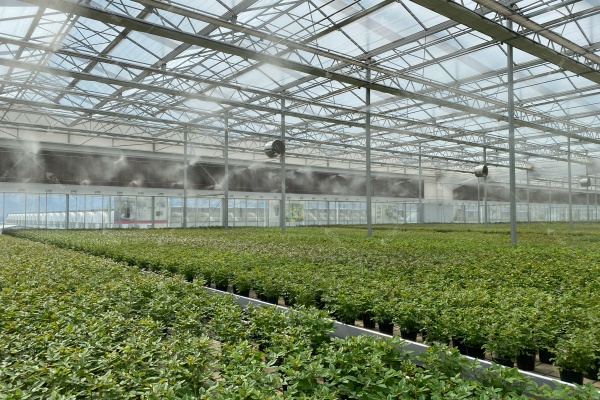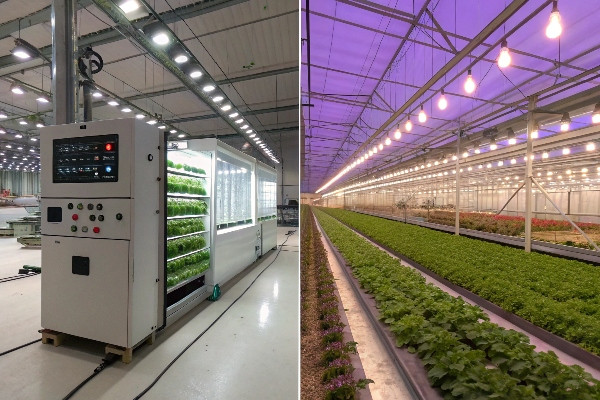Strawberry greenhouse farming promises high yields and premium prices, but many growers face recurring issues that slash profits and increase frustration. These challenges often seem overwhelming without expert guidance.
Strawberry greenhouse farming requires careful management of pollination, nutrients, climate control, and initial investment. With proper planning and the right technology, growers can overcome these challenges to achieve consistent harvests and strong returns on investment.
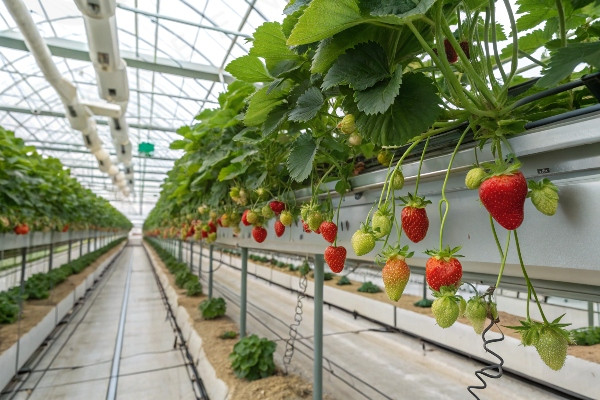
Over my 28 years in the greenhouse industry at CFGET, I’ve visited hundreds of strawberry operations across Southeast Asia, Europe, and Central Asia. The most successful growers all share one trait: they tackle common challenges systematically rather than reactively. Let me share what I’ve learned about overcoming the major hurdles in strawberry greenhouse production.
How to Ensure Proper Pollination for Greenhouse Strawberries?
Poor pollination leads to deformed berries, reduced yields, and financial losses. Many new growers overlook this crucial aspect until they face their first disappointing harvest.
Effective greenhouse strawberry pollination requires introducing bumblebees (1-2 hives per 1000m²), using mechanical vibration, or hand pollination. For optimal results, maintain temperatures between 15-25°C during flowering and ensure 70-80% humidity for proper pollen transfer.
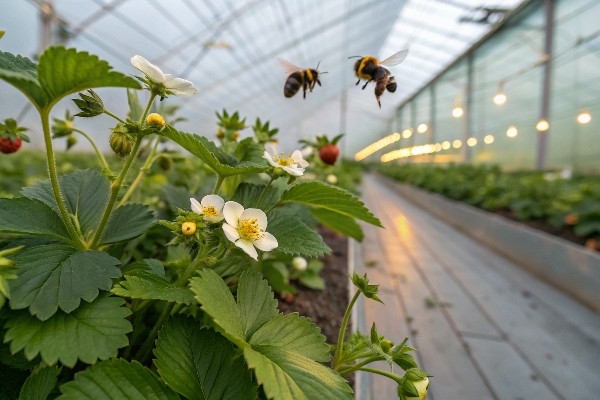
Pollination represents one of the most critical factors in successful strawberry production, yet it’s often underestimated by growers transitioning from outdoor to greenhouse cultivation. In open fields, wind and wild insects handle pollination naturally, but in the controlled environment of a greenhouse, nature needs assistance.
During my visits to strawberry operations in the Netherlands, I noticed their detailed attention to pollination strategies. Most commercial operations rely heavily on bumblebees, which are superior pollinators compared to honeybees for strawberries. Bumblebees work longer hours, in cooler temperatures, and perform "buzz pollination" where they vibrate their bodies to release pollen more effectively.
For small-scale operations under 500m², hand pollination remains a viable option. This involves using a small brush or electric toothbrush to gently vibrate each flower cluster every 2-3 days. While labor-intensive, this method gives growers complete control over the pollination process.
Mechanical pollination systems offer a middle-ground solution. These include blower systems that circulate air forcefully through the crop or vibrating wires that shake the plants gently. I helped implement such a system for a client in Thailand whose greenhouse was located in an area with restrictions on introducing non-native pollinators.
The timing of pollination efforts matters greatly. The stigmas of strawberry flowers remain receptive for only 7-10 days after opening, with optimal receptivity occurring in the first 3-4 days. Temperature control plays a crucial role here—keeping daytime temperatures between 15-25°C optimizes pollen viability and stigma receptivity.
Humidity management also affects pollination success. Too high (above 85%), and pollen becomes sticky and doesn’t transfer well; too low (below 60%), and stigmas may dry out. The sweet spot falls between 70-80% during flowering periods. This balance can be achieved through proper ventilation and, if necessary, fogging systems during dry periods.
Dealing with Nutrient Deficiencies in Hydroponic Strawberry Systems
Nutrient deficiencies can quickly turn promising strawberry crops into struggling plants with poor yields. Many growers misdiagnose these issues, applying incorrect treatments that waste time and money.
Successful hydroponic strawberry cultivation requires precise nutrient management with electrical conductivity (EC) between 1.0-1.8 mS/cm and pH 5.5-6.5. Systems need regular monitoring and adjustment of major nutrients (N-P-K) and micronutrients, especially iron, calcium, and magnesium.
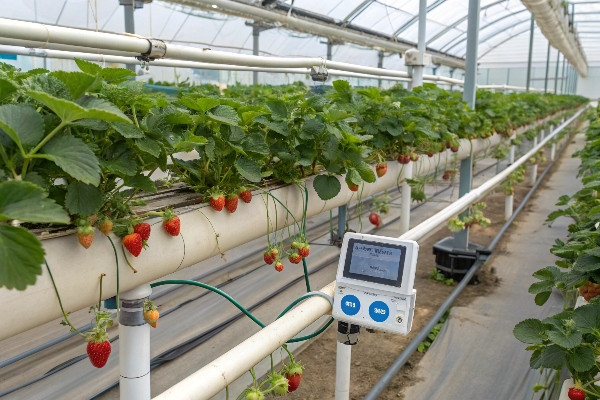
Hydroponic systems offer precise control over plant nutrition, but this advantage comes with responsibility. Unlike soil cultivation where the growing medium can buffer changes, hydroponic systems respond rapidly to both corrections and mistakes. This double-edged sword makes nutrient management both powerful and potentially problematic.
From my experience working with growers across different regions, nutrient deficiencies manifest differently based on growth stage and environmental conditions. For example, during a consultation with a major producer in Poland, we discovered their strawberries were showing interveinal chlorosis—yellowing leaves with green veins. Testing revealed an iron deficiency despite adequate iron in the solution. The problem wasn’t supply but availability, caused by an elevated pH of 7.2 that was limiting iron uptake.
The foundation of successful hydroponic strawberry nutrition starts with understanding the crop’s changing needs throughout its life cycle. During vegetative growth, strawberries require higher nitrogen levels (around 150-200 ppm), while during fruiting, they benefit from reduced nitrogen and increased potassium (200-250 ppm) to improve fruit quality and shelf life.
Monitoring electrical conductivity (EC) provides a quick measure of total dissolved nutrients, with strawberries generally preferring 1.0-1.2 mS/cm during vegetative growth and 1.4-1.8 mS/cm during fruiting. However, these values should be adjusted based on water quality, climate conditions, and cultivar requirements.
Common deficiencies I’ve encountered include:
Calcium deficiency: Recognizable by tip burn on new leaves and poor fruit firmness. This often occurs during rapid growth periods or when humidity levels fluctuate dramatically.
Iron deficiency: Shows as yellowing in young leaves while veins remain green. This typically happens when pH rises above 6.5.
Magnesium deficiency: Identified by interveinal chlorosis in older leaves, often confused with iron deficiency. This appears more frequently in systems using pure water without adequate supplementation.
Implementing a comprehensive monitoring system is crucial. I recommend daily checks of pH and EC, weekly analysis of nutrient solution, and monthly laboratory testing of both solution and plant tissue. Some of our most successful clients in Japan have integrated automated monitoring systems that alert them when parameters drift out of optimal ranges, allowing for immediate corrections before plants show stress symptoms.
For smaller operations where advanced monitoring isn’t feasible, I suggest using color charts for visual diagnosis and maintaining detailed records of all solution changes and plant responses. This documentation proves invaluable for identifying patterns and refining the nutrient program over successive growing seasons.
Preventing Overheating and Ensuring Ventilation in Strawberry Greenhouses
Heat stress damages strawberry plants, reduces flowering, and causes fruit deformities. Many traditional greenhouse designs trap excessive heat, creating unfavorable conditions for optimal strawberry growth.
Effective temperature management for greenhouse strawberries requires maintaining 18-24°C during day and 8-13°C at night. This is achieved through automated ventilation systems, shade screens (30-50% shade), evaporative cooling, and during extreme heat, fog systems that can lower temperatures by 5-10°C.
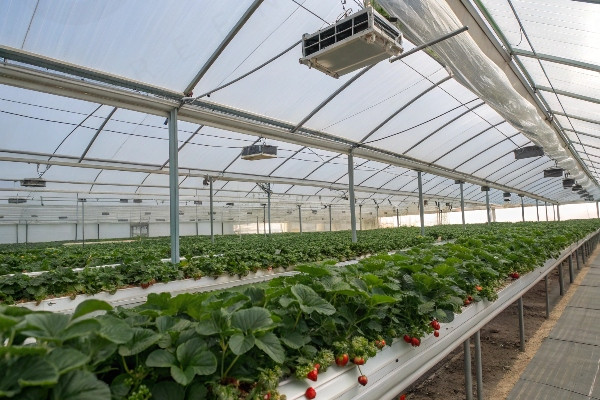
Temperature control represents perhaps the most critical aspect of strawberry greenhouse management. Unlike tomatoes or cucumbers that thrive in warmer environments, strawberries perform best under relatively cool conditions. This requirement creates unique challenges, particularly in warmer regions where I’ve consulted extensively.
During a project in Thailand, we faced temperatures regularly exceeding 35°C during the day. The conventional wisdom suggesting standard ventilation would be sufficient proved completely inadequate. We implemented a multi-layered approach that transformed production outcomes, increasing yields by over 40% compared to their previous season.
The foundation of effective temperature management begins with greenhouse design. East-west orientation maximizes winter light while minimizing summer heat gain. Roof heights of at least 4 meters create a buffer zone where hot air can collect above the crop canopy. For existing structures that cannot be modified, internal circulation fans can help prevent hot spots and ensure uniform temperatures throughout the growing area.
Ventilation requirements for strawberries exceed those of many other crops. I recommend vent openings comprising at least 25-30% of the floor area, with both roof and side vents to create chimney effects that efficiently exhaust hot air. Automated systems that respond to temperature thresholds prove far more effective than manual operation, as they can react quickly to changing conditions, even opening partially during light rain events when manual operators might keep vents closed.
Shade screening represents another crucial element, particularly in high-light regions. Retractable systems offering 30-50% shade provide flexibility, deploying automatically when light levels exceed 800-900 W/m². During my work with a large-scale producer in Spain, we installed external shade screens rather than internal ones, which reduced internal temperatures by an additional 3-4°C compared to their previous internal screening system.
For regions with low humidity, evaporative cooling systems offer remarkable efficiency. Wet wall systems can reduce incoming air temperature by 10-15°C when relative humidity is below 40%. I’ve seen these systems transform otherwise unsuitable locations into productive strawberry operations, though they require careful water quality management to prevent algae growth and calcium deposits that reduce efficiency.
Fog systems provide another powerful tool, particularly during flowering and fruiting periods when even brief exposure to excessive heat can damage reproductive structures. High-pressure fog systems creating droplets under 10 microns can lower air temperature while raising humidity without wetting foliage, which helps prevent disease issues. In a project in Southern China, strategic fog deployment during critical morning hours extended the productive season by nearly three weeks, capturing premium early-market prices.
Root zone cooling represents an often-overlooked approach that can significantly improve plant performance during heat stress. Circulating nutrient solution through cooling systems to maintain root temperatures below 20°C helps plants tolerate higher air temperatures than would otherwise be possible. This technique has proved particularly valuable for our clients in Central Asia who face extreme summer conditions.
What are the Startup Costs for a Commercial Strawberry Greenhouse?
Starting a strawberry greenhouse operation requires significant capital, and unexpected costs surprise many new growers. Without proper financial planning, projects often remain incomplete or operate inefficiently.
A commercial strawberry greenhouse typically costs $25-45 per square foot ($270-485/m²) for complete setup, including $15-25/ft² for structure, $5-10/ft² for environmental controls, and $5-10/ft² for growing systems. A one-acre operation requires $1-2 million investment but can generate $100,000-200,000 annual profit.
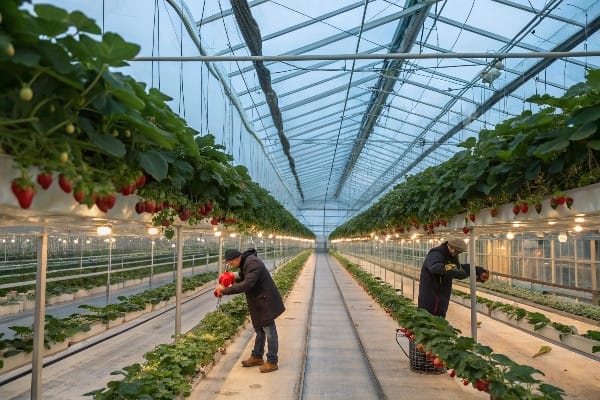
Understanding the economics of greenhouse strawberry production has been a critical part of my advisory work with clients across different regions. The initial investment can seem daunting, but detailed planning prevents costly surprises and ensures viability. Based on numerous projects I’ve overseen, I can provide realistic cost expectations tailored to different approaches.
The greenhouse structure represents the most significant initial expense. Film greenhouses, preferred by about 80% of strawberry growers, cost substantially less than glass structures—typically $15-20 per square foot ($160-215/m²) compared to $30-45 per square foot ($320-485/m²) for glass. This difference explains their popularity, particularly among new entrants to the market.
The choice between film and glass involves tradeoffs beyond just initial cost. Film structures require covering replacement every 3-5 years, creating ongoing expenses and brief production interruptions. Glass structures, while more expensive initially, offer better light transmission, improved insulation, and longevity often exceeding 25 years. For a client in Germany, we calculated that the higher productivity and energy savings from their glass structure would offset the additional cost within 7 years, after which the operation would enjoy significantly higher margins than comparable film greenhouses.
Environmental control systems constitute the next major expense category. Basic systems providing ventilation, heating, and simple humidity control typically cost $5-7 per square foot ($54-75/m²). Advanced systems adding CO₂ enrichment, automated shade/energy curtains, and precision control can reach $10-15 per square foot ($107-160/m²). While the advanced systems require greater upfront investment, they typically reduce labor requirements and increase yields by 15-25%, offering attractive returns for operations in competitive markets.
Growing systems vary widely based on approach. Traditional soil cultivation with basic irrigation can be established for $3-5 per square foot ($32-54/m²). In contrast, advanced hydroponic systems with precise nutrient delivery, substrate, and supporting structures range from $8-12 per square foot ($86-130/m²). The trough systems commonly used for strawberries typically fall in the middle of this range.
Beyond these primary categories, additional costs include:
- Land acquisition: Highly variable by location, but typically $10,000-50,000 per acre
- Utilities setup: Water wells, electrical connections, and gas lines often cost $25,000-75,000
- Permits and engineering: $15,000-50,000 depending on jurisdiction
- Initial plant material: $0.30-0.60 per plant, with typical density of 20,000-30,000 plants per acre
- Labor during setup: Often overlooked but can reach $30,000-50,000 before the first harvest
Operating costs also require careful planning. Labor represents the largest ongoing expense, typically consuming 40-45% of operating budgets. Energy costs follow at 15-25%, then growing media/fertilizer at 10-15%, packaging at 5-10%, and miscellaneous expenses making up the remainder.
Revenue projections must account for seasonality and market positioning. Premium cultivars and organic certification can command prices 30-50% above conventional products. Year-round production strategies, while requiring more sophisticated systems, spread fixed costs across greater production volume and allow growers to capture off-season premium pricing.
A well-designed one-acre strawberry greenhouse can produce 10-15 tons of fruit annually under basic management and up to 25-30 tons with optimal conditions and advanced systems. Current wholesale prices range from $2.00-4.50 per pound depending on season and market, translating to gross revenues of $40,000-270,000 per acre, with typical operations falling in the $100,000-200,000 range.
Conclusion
Managing pollination, nutrients, temperature, and finances strategically enables successful strawberry greenhouse farming. With the right systems tailored to strawberry needs, growers can overcome common challenges and achieve sustainable, profitable production year after year.

